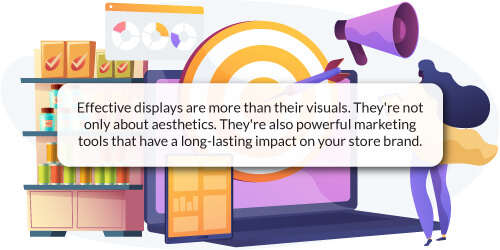In retail, where first impressions matter, captivating product displays make all the difference. But what happens if you're a small retailer on a tight budget? How can you stand out against competitors who don't have the same concern about spending as you do? Fortunately, you don't need deep pockets to create displays that capture your customers' attention.

But you do need to be strategic in how you create them. After all, when done right, they can enhance your brand image, encourage impulse purchases and boost your sales.
Having limited funds, space or resources can be frustrating, but these are barriers that you can overcome. Ready to transform your retail space and create eye-catching displays? Let's get started.

Understand what your customers expect
It may appear counterproductive that we're focusing on your customer in an article about creating eye-catching product displays, but we're doing that for a good reason.

Attracting the right customers begins with understanding them. There are a few actions you can take to do just that. Moreover, they're all easy to implement and aren’t costly.
1. Observe their browsing and shopping habits
Watch your customers as they browse your store. What sections or types of products are they drawn towards? These product categories and areas in-store could be perfect for a display.
How long do they spend in different sections of your store? Which products do they interact with the most? How do they move through your store? Also, look at your monthly (and historic) sales data to understand what customers buy. What are your most popular products?
You could use all this information when deciding what you place on displays and where to position them.
2. Gather insights through customer surveys and feedback cards
Asking your customers about their experience in your store is a great way to gather insights. Develop short surveys and use feedback cards to learn more about their preferences.
Questions can focus on their favorite products, how often they visit your store and why they visited, what they think about current product displays, and if they have suggestions for improvements. You can email these surveys, send them out via your social media channels, or have them at your point of sale.
The challenge here is encouraging them to complete these surveys.
You can make it worth their time by placing the feedback cards and collection boxes at your checkout areas. You could also provide small incentives, like a discount for the next time they shop at your store or a free entry into a raffle.
To be as non-intrusive as possible, make the surveys short, keep the questions relevant to the customer, and make it optional so you don’t come across as pushy. For example, add a mix of rating scales (1 to 5), multiple choice, and open-ended questions.
Other actions include using your social media channels to run polls, ask questions, and encourage your followers to share their thoughts and ideas. You can also use popular trends to inform your displays.

Consider where you place your displays
1. Leverage your checkout areas
There are many ways to maximize your checkout area and create eye-catching spaces. That includes highlighting impulse buys, creating a grab-and-go section, or utilizing shelving and baskets.
For impulse buy displays, for example, use color, shape, and height variations in your product arrangement to catch the eye. The signage you use is also critical to stand out to shoppers. Product examples include confectionary and snacks, small gadgets and items, accessories, and seasonal items.
For a grab-and-go section, use compact shelving units that can fit into your space or group products by type or use. For example, have a section for snacks, one for drinks, and others for small gadgets or accessories. Also, have clear labels to make it easier for your customers to know the price before adding it to their basket.
If you have limited horizontal space, consider installing shelves and hanging products above the counter to draw their eyes. However, you need to be mindful of obstructing or cluttering your space, which could frustrate paying shoppers. In this case, less is more - focus on one product grouping and keep it neat and tidy.
2. Capitalize on hotspots
Hotspots are areas in your store where customers tend to spend the most time. After identifying these areas, you can display new arrivals or high-margin items.
Identify your hotspots by checking your sales data. Your point of sales system can tell you what's selling well and give you some clues. If high-selling items are in a specific area, it could indicate a hotspot. Capitalize on that by setting up a display that makes it easier for shoppers to add a product to their basket.
Alternatively, try an experiment. Place new arrivals in two different areas and monitor how each display performs. Compare them against each other and make a change if necessary.
3. Utilize endcaps
Endcaps are unique display fixtures that draw the eye, which is why they are so effective. They also aim to sell more products. Moreover, you don't need to rearrange your store because they are at the end of your aisles or gondolas.
Instead, you can maximize this space. Clear an endcap on a chosen aisle and begin arranging it. You could group related products to promote a complete experience - all the ingredients for a popular recipe, for example.
It's also a good idea to create height and depth by arranging products into a pyramid or an eye-catching shape. The shape could be related directly to the brand logo if it's a single product or a related object if there are multiple products.

Include thematic displays where possible
1. Tell a story
We mentioned it already, albeit in passing, but a good display tells a story.
It should take your customers on a journey, demonstrating how they can use a product or products in their lives. It can also include products that fit a specific theme or trend. Remember we mentioned understanding your customers by asking them questions and learning about what they like and expect from you?
Using that information, you can develop an appropriate display that tells a story that matches their needs. You could also match their needs against the season or around a product.
For example, if you are a home goods store, you could create a room or living space, allowing shoppers to visualize how different products would look in their homes. You don't need a large budget to create such a scene.
2. Include products with different price points
The products in your display don't need to be the same price. It's also worth creating a display that includes products across different prices.
For example, if you're a small fashion boutique, you could pair a top-of-the-line designer bag with more affordable clothing items that match. Remember, this is about creating an attainable look for many customers rather than one or two. It also helps to cater to your different customer segments and even promote upselling.
Taking the home goods store example, you could pair luxury decor with budget-friendly accessories to demonstrate that you don't need to spend a lot to get what you want.
3. Take advantage of available resources
An eye-catching display doesn't require a large budget. Instead, it's about being creative and resourceful with what you have available.
You can repurpose in-store items, for example. Be careful of taking any old item and adding it to a display. Does the item fit the theme or tell the story? If not, then don't use it. Repurposing items allows you to add depth and interest to your displays.
Thrift shopping is another good idea. If you want to tell a travel story, you can search for an old battered suitcase. What you use doesn't need to be pristine to tell a good story. Instead, each item needs to fit what type of story you want to tell.
If you don't have any suitable items, why not borrow them? Do you have a friend or business connection who can provide you with a mannequin or display stand? Ask your staff - do they have an item that would fit perfectly into the story? If you're near a beach or forest and want to include a summer or autumn-themed display, you can collect sand, shells, or leaves to complete the look.

Pay attention to your lighting
1. LED lights
LED lights are cost-effective and come in various shapes and sizes. They also consume less power and last longer, which makes them the perfect option.
For example, if you're a clothing retailer, you could use a soft, warm color to highlight a mannequin wearing a winter outfit, making it more appealing. The different colors you use also help create different moods.
For example, blue lights may create a calming environment, whereas warmer red or yellow lights might create a more energetic or inviting atmosphere.
2. Spotlights
If you want to highlight a specific product over others, you can use a spotlight. While it draws attention to one product, you can use it creatively to show there is more to a display than a single item.
For example, a bookstore might want to spotlight a recently published book that the author happened to sign. The light pulls your customers in to find out more. Meanwhile, you can include other books from the same author or within the same genre to keep them browsing your display. The longer they browse, the higher the chance of adding an item to their basket.
You could do the same for any high-end items, new arrivals, or products on promotion.
3. Natural light
Paying for lighting is one way to go, but what about using natural light?
You can maximize your use of natural light by placing your displays in sunlit areas. If you have large windows or skylights, place them nearby or directly underneath to get the full impact.
Of course, there are potential drawbacks, such as causing glare or heating the area and making it uncomfortably hot. To manage that, you can use blinds, curtains, or subtle shading and position your products in a way that doesn't cause discomfort.

Utilize balance in your displays
1. Use what you have
Utilizing balance doesn't require expensive props. You can achieve it with the products you have on display. It includes not just physical items but also different colors, textures, and types of products. For instance, balancing darker and lighter colors or smooth and rough textures can create visual interest and make your displays more appealing.
Let's go back to the bookstore example. In this instance, you could arrange your books from shortest to tallest or by color gradient. You could use a color gradient in any display, regardless of what you sell.
2. Play with heights
To add depth and texture to your displays, play with heights. Doing so adds an extra dimension to your displays, transforming them from stock-standard and dull to dynamic and engaging. You can use any object that fits the display theme to complete the look and keep your customers interested.
For example, if you are a small fashion boutique, you could have shoes on the floor, folded jeans on the first level, a blouse or shirt on the second level, and hats or other accessories above that. This cascading effect draws the eye up and down while showing your customers how an outfit would look if they bought it.
3. Less is more
A cluttered space is the last thing you want to create when setting up displays as a small retailer. Instead, focus on one or two items and ensure enough space around the area so shoppers can move around.
For example, if you sell groceries, you could create a display focused on a specific product, like seasonal or exotic fruit. It might be a new product that you want to show off. Not only does that create a visually-appealing display, but it also gives the product an exclusivity that attracts customers and could drive sales.
However, also ensure that there are complementary items around that can lead to impulse buys or increased sales.

Evaluate your displays and tweak
1. Check your sales data
If in doubt about anything you do in-store, the best action to take is to check your sales data. It's also the most direct way of gauging the impact of your displays.
With regards to what to track, that depends on your goals. If you want to increase sales for a specific product, quantity sold could be one of your primary key performance indicators. Before you do, establish a baseline to compare and identify any changes in sales patterns.
Then, track your sales while the display is up. Don't forget to account for other factors that might impact sales, such as holidays or store promotions. After you've collected data for the duration of your display, compare it against your baseline.
Did sales for a product increase? If it did, it suggests your display works. You could also look at the other items customers purchased alongside the displayed product/s. If you notice an uptick in related or complementary products, it's a sign that your thematic display worked.
2. Gather customer feedback
Creating eye-catching product displays begins by understanding what your customer expects and ends with getting their feedback on whether or not you delivered.
You can gather feedback through in-store surveys, feedback boxes, or social media polls. If you are bold enough, you can ask customers in-store while they're at the display.
An in-store survey could include a simple rating scale or yes/no questions to understand if your customers liked your displays and whether it influenced their purchase decision.
If you know they bought something from the display (linking your sales data to loyalty card data, for example), you could email them asking for their feedback.
You can leave feedback boxes and cards near the display asking specific questions. You could incentivize them to provide feedback by offering a 5% or 10% discount to the first 20 people who do that. If you have a social media presence, you could run polls, post photos of the display and ask your followers to rate and comment.
3. Observe foot and store traffic
Foot traffic data can provide you with critical information that you can use to improve your store layout and displays.
One way to monitor foot traffic is to consider manual counting. It's the simplest and most cost-effective method, but it's not as accurate or comprehensive as other strategies. Consider assigning a staff member to count how many people walk into your store and visit your display.
If you have the budget, you could invest in retail analytics software to track movement and understand your in-store hotspots and dead zones. A good indication of whether or not your displays are working is if you notice they are becoming hotspots.
Finally, consider the paths your customers take when they enter your store. Are they drawn to your product displays, or do they walk past? With the gathered information, you can decide where to place them in-store for maximum exposure.
Conclusion
Creating captivating product displays is within reach, no matter your budget. You have the power to enhance your customer's experience and drive sales. Don't wait.
Supercharge your retail business today. Experience the difference with a free 14-day trial of DotActiv Lite – the key to your display success. Start your journey on our online store now.


